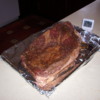I have a SM050. Been cooking with it about a year. Once you figure them out they are great cookers.
Have been reading post on this forum for about a year and have learned a lot of valuable tips. Learned things I hadn't known from 30 years of cooking on offsets etc. Wonder now how I ever got some things to turn out good.
In reading some of the post, I've read where some folks will turn on their cookers then leave for several hours. Normally that wouldn't be a problem. However, last weekend, if I'd not been here, the cooker may have very well caught on fire.
I cooked a brisket and ribs starting at 6:00 AM. Cooker set at 200 for about 12 hours total. At around 6 I turned the cooker up to 250 to finish off brisket. I use a Maverick remote thermometer. The temperature never got over 208 for the next couple of hours. No big deal but it's never done that before. Turned cooker off around 8. About 9 I turned the cooker back on to 250 to see if it would heat to 250. In about 30 min. the cooker was up to around 297. That was a higher temp than it had ever reached before but I just figured it was just a freak incident. I turned it off and forgot about it. (Didn't unplug it)About an hour later my wife said she smelled something burning or smoking. I knew I'd turned it off but went out on the back porch to check the cooker. There was smoke bellowing out of the exhuast hole. The dial was in the off position but the cooker was obviously on. I then unplugged it and opened the door. Heating element was bright orange and the cooker was very very hot. My guess would be in the 5-600 degree range. Wish now I'd have checked the temp with the Maverick thermometer but I'd already put it up.Stainless top was too hot to touch. Obviously the thermostat or something had gone haywire.
Cooker is kept on a covered porch and is also kept covered when not in use with one of Cookshack's covers. Unit has never gotten wet etc. I do not use an extension cord. I can't think of any outside factors that could have caused this to happen.
I contacted Cookshack on Monday and they responded quickly. They said it was probably the thermostat that had gone bad. They sent me a new one that arrived yesterday. I will attempt to replace it today or tomorrow.
I think this is probably something very rare but it convinced me that I should never leave the cooker for more than an hour or so. I also think that if you use an electronic thermometer, you should set the high temp alarm to go off at 300-350.
Just wanted to relay this in case some of you start you cooks early in the morning and then leave. Also, be sure to uplug your cooker when you are finished!
By the way,,,food I cooked was very good. Tried my first Angus brisket. Was expensive but probably worth it.
Original Post
